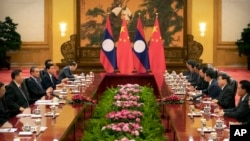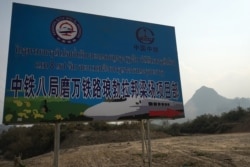Laos is not likely to make all its debt payments this year, much of them owed to China, which has become the world’s biggest lender, more so than the World Bank or any other global institution, according to analysts.
When Vientiane’s bills come due, how will renegotiations affect Beijing’s growing influence in its fellow communist nation? The question is also part of a broader one being asked about Beijing’s influence around Southeast Asia.
Laos was already at high risk of what analysts called “debt distress” before the coronavirus pandemic, but COVID-19 has only raised the risks of its foreign borrowing.
Fitch Ratings downgraded its official outlook on the Lao economy to “negative” from “stable” last month, based largely on whether Laos can pay back foreign loans in the wake of the crisis. Currently, Laos has 19 coronavirus confirmed cases, according to Johns Hopkins University.
The risk can be seen in the data. The debt that Laos owes China amounts to about 45% of the smaller nation’s gross domestic product, which is the highest percentage among nations included in a 2019 analysis by the Lowy Institute, an Australian research group.
“Laos has accumulated significant external debt over the past decade in relation to major new hydroelectric projects, as well as Belt and Road infrastructure projects,” said Rajiv Biswas, Asia Pacific chief economist at London-based analytics company IHS Markit. In an interview with VOA, Biswas also said this has “increased the debt repayment burden over the medium term.”
The hydroelectric projects and the roughly half-a-trillion-dollar Belt and Road initiative are part of a program by China to build ties with scores of nations through infrastructure. The initiative would link China to Europe, Africa and other parts of Asia. There are concerns about the level of debt some countries would take on regarding such investments. China has said there are no conditions attached to its investments and loans.
Geopolitics
Fitch reckons Laos has foreign exchange reserves of $1 billion and will owe $900 million in external debt payments this year. It also forecast state revenues will contract about 25%. It said, if the one-party state can’t meet payment deadlines, lenders dominated by China would be motivated to forgive Laos’ loans or help it pay them with new lending.
“Geopolitical considerations and economic interests are likely to spur further bilateral lending, or debt relief, in the absence of sufficient financing from other sources,” Fitch said. It is not clear what Beijing would want in return for its generosity.
The United States worries China aims to become too powerful over the 10-member Association of Southeast Asian Nations. U.S. Secretary of State Mike Pompeo held a video conference with the ASEAN foreign ministers in April, warning them China has built more territory in the disputed South China Sea, sunk a Vietnamese fishing boat this year, and dammed up the Mekong River, which could limit the fish and nutrients that flow downstream to Laos, Cambodia, Thailand and Vietnam.
“The United States strongly opposes China’s bullying,” he said. “We hope other nations will hold them to account, too.”
World’s biggest lender
China and the U.S. have both increasingly sought to build ties with Southeast Asia in arenas from geopolitics to business. Cloud companies like Microsoft and Google compete with Chinese giants Huawei and Alibaba for customers around the region.
In one of the biggest recent business transactions, Facebook and PayPal, both based in California, bought stakes in Indonesian ride-hailing company Gojek, which already has investment from Chinese tech company Tencent.
Infrastructure financing is another arena for influence, which China exercises through Belt and Road, and the U.S. through its “Indo-Pacific” spending program. The Asian nation’s lending is far higher, though. Germany's Kiel Institute analyzed data last year and concluded Beijing has become the world’s biggest lender, overtaking groups like the International Monetary Fund and the World Bank. It said from 2000-2017 other nations’ debt to China “soared ten-fold, from less than $500 billion to more than $5 trillion.”
Laos is one of the most indebted of those nations. What China gets from the bilateral relationship ranges from Vientiane resisting joint ASEAN action in the South China Sea, to a pending rail line that will link China to Laos and, eventually, its neighbors. Laos is also one of the first nations, along with Cambodia, to sign plans that “endorse China’s regional vision of a community of common destiny,” said Brookings Institution senior fellow Jonathan Stromseth.
“China is becoming more involved in the domestic affairs of Southeast Asian countries,” he said in a November report.
Examples include China recruiting Southeast Asians for study tours and training, as well as calling on its diaspora in the region to act as a diplomatic bridge, he said, adding, “China has stepped up activities in target countries to influence outcomes and public opinion.”










